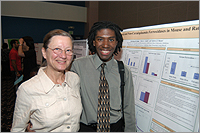| 
Linder Receives Grant to Explore How the Trace Element Copper Finds Its Way to Newborns
BY DAVE REID
From Dateline (May 20, 2004)
 |
| Lawrence Gray, a junior
majoring in biological science, greets his mentor, Maria
Linder, professor of chemistry and biochemistry, during
last monthís Minority Biomedical Research Support program
symposium. Gray, whose research project explored how mice
appear to have a different mechanism for transporting
iron in the body, was a runner-up in the undergraduate
biological and agricultural sciences category in the April
30 CSU Student Research Competition at Cal State Northridge.
Linder recently received a grant to delve into how copper
is transported in mammals from mothers to newborns. |
|
 |
Copper and other metallic elements are required
in minute amounts by all biological organisms for health, growth
and survival.
Usually in humans and most other mammals, traces
of copper from food enter the blood stream and are transported to
the liver, then distributed to other parts of the body as needed.
The excess is excreted by the liver.
A notable exception to this occurs in mammals when
nursing their young. At that time, copper is diverted from the liver
to the females’ mammary glands, where it enters the milk newborns
drink. Copper helps newborns survive and grow and may have other
functions in the digestive tract.
This diversion phenomenon and related copper transport
issues are the basis of research currently being conducted by Maria
Linder, professor of chemistry and biochemistry. Her investigation
is funded by a five-year National Institutes of Health grant of
which first-year funding is $244,332.
“There are important nutritional implications
to this research,” says Linder, who has taught on campus since
1977. “Our research is expected to reveal a lot about the
basic transport processes involved in supporting the metabolic roles
of copper in the body.”
Linder’s goal is to determine the processes
within a cell that allow transfer of copper across membranes and
through cell compartments to copper-binding proteins that then leave
the cell and enter breast milk.
“I originally began to study copper because
of its implications for cancer,” notes Linder, who received
her doctorate in biochemistry from Harvard University, and conducted
post-doctoral research at Harvard and MIT.
“We know that in cancer patients the amount
of copper in the bloodstream goes up. Cancer cells are hungry for
copper, but certain copper compounds also inhibit cancer growth,”
she explains. “Understanding the normal roles and transport
of copper will thus help us to understand this disease.”
Linder will be working with colleagues from Deakin
University in Australia and students from both institutions. One
CSUF student will go to Australia this summer, and Deakin may send
one or more students to study with Linder.
The veteran researcher has received many awards for
her work, including the American Chemical Society Award for Research
at an Undergraduate Institution and the CSUF Outstanding Professor
Award. Her research on copper and iron biochemistry has been published
in professional journals and supported by the National Institutes
of Health and other agencies.
« back to Research
|